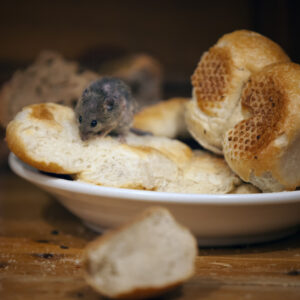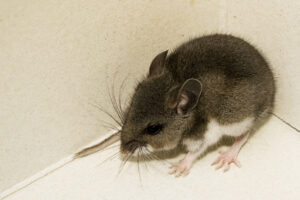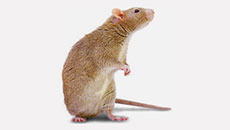Rodents: The Good, The Bad and The Ugly
The presence or sign of mice or rats in your home can be overwhelming. Knowing the signs of infestation and where these pests like to hide is a good start to uncovering a problem and working towards a solution for removal.
Common signs of rodent infestation include droppings; gnaw marks on food containers and a musty smell. Rodents are opportunistic pests and highly adaptable to any environment. Humans have unintentionally provided them with a warm and inviting environment with easy access to both food and shelter.
Rats can wriggle through a hole the size of a nickel, and mice only need an opening the size of a dime to gain access to your house. In their natural outdoor habitat, rats and mice reproduce in the spring and fall. However, they are able to reproduce year round when living indoors.
Rodents can gnaw through lead pipes, electrical wires, and wooden structures and are capable of causing a lot of damage to your home and surrounding outdoor structures. Rats and mice also transmit diseases to both pets and humans, including the deadly Hantavirus, for which there is no known cure.
Loss of their natural territory due to urban development, mild winters and weather-related disasters are all factors that can lead to an increase in the rat and mice population. Rodent infestation can occur at anytime but is more frequent during inclement weather as the pests look for access into your home during times of cold and/or rainy weather.
Common Rodents Found in Canadian Households
There are many types of rodents common to North America, found throughout homes and offices in both the United States and Canada. Besides the usual suspects detailed below, other rodents found in Canada include voles, shrews, moles, gophers and wood rats.
If you are experiencing a rodent invasion, here is a short list of the rats and mice typically found in Canadian homes and offices.
House Mouse

House mice are 2 1/2 to 4 inches long and have large ears. They can live for 1 to 2 years and reach sexual maturity at only 1 month old and have a 20-day gestation period. A typical litter size is five to seven pups and each female mouse can produce six to 10 liters per year. This prolific reproduction rate means each adult female is capable of producing from 30 to 70 babies per year!
Common signs of infestation include lots of droppings, a musty odor and gnaw marks on cereal boxes and food containers. Their droppings are dark-coloured, 1/4 inch long and have pointed ends. A single adult house mouse is capable of producing between 50 and 75 droppings per day.
A domestic house mouse only needs an opening the size of a dime to gain access to your home. Effective preventive measures include closing off all openings around your home’s foundation, eliminating clutter and debris to reduce the chance of their nesting, and careful food storage. House mice are nocturnal and come out at night to feed on cereal, grains, meats and seeds.
Deer Mouse

Deer mice are larger than house mice and are around 4 inches long with a 2 inch long tail. They can live for up to 2 years and reach sexual maturity at only 1 month old. With a 20-day gestation period, each adult female can produce two to four litters per year, with up to four pups per litter.
Like the house mouse, deer mice only need an opening the size of a dime to gain access to your home. These mice feed on grains, seeds, fruits, berries and insects. Their droppings look just like house mice droppings and are ¼ inch long, dark-coloured with pointed ends. Each adult mouse is capable of producing 50 to 70 droppings per day. Typical signs of infestation include droppings; gnaw marks and a musty odor from their urine and droppings.
They can be found beneath decks, garages and barns and even inside cars. Deer mice are known to chew on wires, gnaw plastic items, wood structures, and the corners of cereal boxes. They also shred paper from books and paper towels to use for their nests. Deer mice are known carriers of the deadly Hantavirus, which is found in the urine, saliva and droppings of infected mice. Hantavirus is a serous lung disease, with no known cure, and is fatal in up to 40% of people who get infected.
Norway Rat

These rodents are sometimes called Super Rats because they can grow up to 16 inches long including their tail. They are typically 7 to 10 inches long with a 6 to 8 inch long tail. They are larger than roof rats and have small ears and large, protruding black eyes. They have gray-brown fur, which ranges from pure gray to reddish-brown. They are hard to identify by colour alone, as their fur can look like a roof rat, but their tails are always shorter than their body.
Despite their large size, Norway rats can squeeze into an opening only ½ inch wide, which is about the size of a nickel! Norway rats reach sexual maturity at 2 to 3 months and their gestation period is 22 days. Each adult female rat can produce four to seven litters per year with eight to 12 pups per litter. Their droppings are dark-coloured, ¾ inch long with blunt ends and usually found in clusters.
They are nocturnal feeders and their territory is 25 to 100 feet from their nests. These rats burrow in the soil and are found in sewers, basements and the lower portion of buildings. They eat cereal grains, meets, seeds, fruits and insects. They also like to chew on wood structures including corners, floor joists and wall studs.
Roof Rat

These rats are smaller than Norway rats and are 6 to 8 inches long with a 7 to 10 inch long tail. They are hard to identify by colour alone and are black to brownish-gray with a tail that is longer than their body. They have large eyes and a slender body with pointed nose.
They are called roof rats because they infest the upper portion of buildings including attics and false ceilings. They are also found nesting outdoors in dead palms fronds and other yard debris. They like to chew on wires, which can result in power outages or fire. Their droppings are ½ inch long with pointed ends, dark-coloured and scattered. Each adult rat is capable of producing from 40 to 50 droppings per day.
They live from 5 to 18 months and reach sexual maturity at 2 to 3 months. With a gestation period of 22 days, adult females produce three to four litters per year with four to eight pups per litter. Roof rats are usually found along coastal areas and typically venture no further than 100 miles inland. Their range is up to 300 feet from their nest.
Rodent Control
A variety of methods are available to Canadian homeowners to help you control mice and rat infestations. You can find traps, poisons and ultrasound devices at your local home improvement store to help you get rid of rodents in the home.
Traps
Snap traps, glue traps and electronic traps are available for both rats and mice. Place the traps between the walls they are nesting in and their food source. Rats are leery of new items so it might take a few days before you catch any.
Make sure you buy the right sized trap for your problem. A trap meant for a mouse will probably be too small to effectively trap a rat. And a rat trap is entirely too big for trapping and getting rid of mice.
Ultrasound Devices
Ultrasound devices work by discouraging the mice or rats from entering your home in the first place. This control measure works by emitting high-pitched sound waves and can help chase any existing rodents out of your home. The sound from these devices does not travel between walls, so you will need to use one device in each room where you see signs of infestation.
Rodenticides
There are many poisonous baits and pellets that can be used to kill rodents. A major problem with this method is that there is no way to control where the pest will die. If a rat or mouse dies inside your walls, the smell can last for a long time as they decompose.
Just Say No to Mice and Rats
Prevention is key to avoiding a pest infestation in your home. Do a thorough walk around your property to look for signs of rodent infestation. Rats and mice typically gain access to your home through basements, crawl spaces and plumbing pipes.
Mice and rats are attracted to a variety of food sources including garbage, pet food, compost bins, vegetable gardens and bird feeders. Keeping your home well maintained and cleared from yard and other debris will go a long way towards detracting rats and mice from invading your home.
Pest Control Throughout the Year
While mechanical and electrical traps and poisons may eliminate some of the pests, a pest professional can better deal with a serious infestation. A pest control service can offer a complete solution to get rid of existing rats and mice and prevent new rodents from entering your home in the future.
If you are looking for Canadian rodent control, you can visit our website at www.trulynolen.ca for more information. At Truly Nolen Canada, we will provide a customized solution to your existing infestation and can place you on a preventative maintenance plan to make sure your home remains rodent free.
Call 877-977-1553 today for your free inspection and protect your home, and your health. Proudly serving: Dundas, Ancaster, Oakville, Hamilton and Burlington.